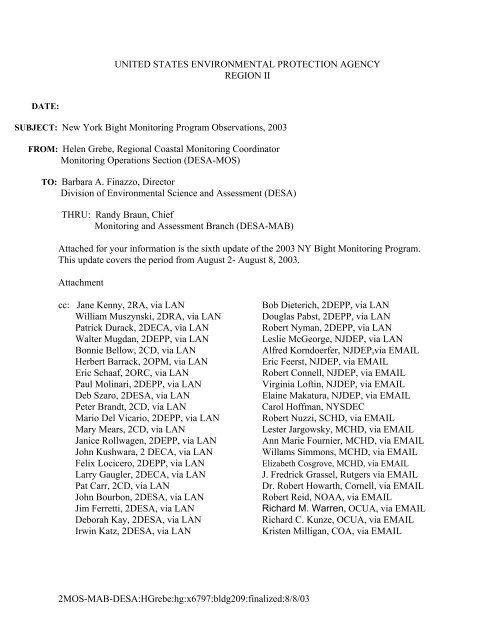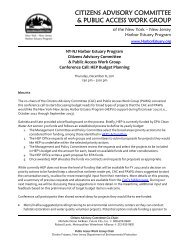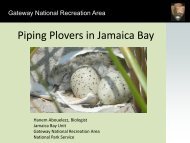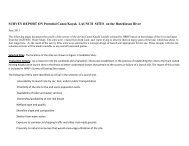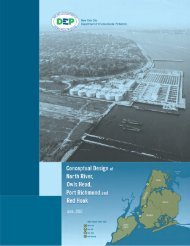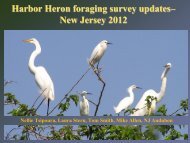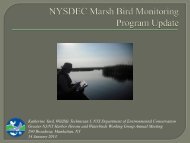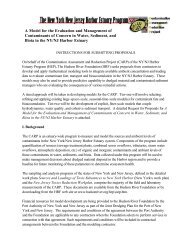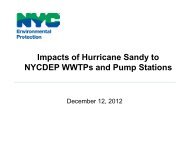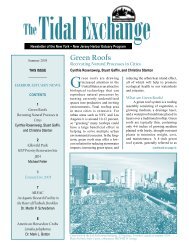UNITED STATES ENVIRONMENTAL PROTECTION AGENCY ...
UNITED STATES ENVIRONMENTAL PROTECTION AGENCY ...
UNITED STATES ENVIRONMENTAL PROTECTION AGENCY ...
You also want an ePaper? Increase the reach of your titles
YUMPU automatically turns print PDFs into web optimized ePapers that Google loves.
DATE:<br />
<strong>UNITED</strong> <strong>STATES</strong> <strong>ENVIRONMENTAL</strong> <strong>PROTECTION</strong> <strong>AGENCY</strong><br />
REGION II<br />
SUBJECT: New York Bight Monitoring Program Observations, 2003<br />
FROM: Helen Grebe, Regional Coastal Monitoring Coordinator<br />
Monitoring Operations Section (DESA-MOS)<br />
TO: Barbara A. Finazzo, Director<br />
Division of Environmental Science and Assessment (DESA)<br />
THRU: Randy Braun, Chief<br />
Monitoring and Assessment Branch (DESA-MAB)<br />
Attached for your information is the sixth update of the 2003 NY Bight Monitoring Program.<br />
This update covers the period from August 2- August 8, 2003.<br />
Attachment<br />
cc: Jane Kenny, 2RA, via LAN Bob Dieterich, 2DEPP, via LAN<br />
William Muszynski, 2DRA, via LAN Douglas Pabst, 2DEPP, via LAN<br />
Patrick Durack, 2DECA, via LAN Robert Nyman, 2DEPP, via LAN<br />
Walter Mugdan, 2DEPP, via LAN Leslie McGeorge, NJDEP, via LAN<br />
Bonnie Bellow, 2CD, via LAN Alfred Korndoerfer, NJDEP,via EMAIL<br />
Herbert Barrack, 2OPM, via LAN Eric Feerst, NJDEP, via EMAIL<br />
Eric Schaaf, 2ORC, via LAN Robert Connell, NJDEP, via EMAIL<br />
Paul Molinari, 2DEPP, via LAN Virginia Loftin, NJDEP, via EMAIL<br />
Deb Szaro, 2DESA, via LAN Elaine Makatura, NJDEP, via EMAIL<br />
Peter Brandt, 2CD, via LAN Carol Hoffman, NYSDEC<br />
Mario Del Vicario, 2DEPP, via LAN Robert Nuzzi, SCHD, via EMAIL<br />
Mary Mears, 2CD, via LAN Lester Jargowsky, MCHD, via EMAIL<br />
Janice Rollwagen, 2DEPP, via LAN Ann Marie Fournier, MCHD, via EMAIL<br />
John Kushwara, 2 DECA, via LAN Willams Simmons, MCHD, via EMAIL<br />
Felix Locicero, 2DEPP, via LAN Elizabeth Cosgrove, MCHD, via EMAIL<br />
Larry Gaugler, 2DECA, via LAN J. Fredrick Grassel, Rutgers via EMAIL<br />
Pat Carr, 2CD, via LAN Dr. Robert Howarth, Cornell, via EMAIL<br />
John Bourbon, 2DESA, via LAN Robert Reid, NOAA, via EMAIL<br />
Jim Ferretti, 2DESA, via LAN Richard M. Warren, OCUA, via EMAIL<br />
Deborah Kay, 2DESA, via LAN Richard C. Kunze, OCUA, via EMAIL<br />
Irwin Katz, 2DESA, via LAN Kristen Milligan, COA, via EMAIL<br />
2MOS-MAB-DESA:HGrebe:hg:x6797:bldg209:finalized:8/8/03
2MOS-MAB 2MOS-MAB 2MAB-DESA<br />
Grebe Glogower Braun<br />
UPDATE OF NY BIGHT MONITORING PROGRAM FROM August 2 - August 8, 2003<br />
NY Bight Sampling has been as follows:<br />
August 2 NY/NJ Harbor Complex Cancelled due to inclement weather<br />
August 4 NY/NJ Harbor Complex Cancelled due to inclement weather<br />
Perpendiculars Cancelled due to inclement weather<br />
August 5 NY/NJ Harbor Complex Cancelled due to inclement weather<br />
LI Beaches Cancelled due to inclement weather<br />
August 6 NY/NJ Harbor Complex Overflight<br />
Phytoplankton NJ Coast and Back Bays<br />
NJ Beaches Sandy Hook to Cape May<br />
August 7 NY/NJ Harbor Complex Cancelled due to inclement weather<br />
Perpendiculars Cancelled due to inclement weather<br />
August 8 NY/NJ Harbor Complex Cancelled due to inclement weather<br />
Perpendiculars Cancelled due to inclement weather<br />
Projected Activities for Next Week:<br />
August 9 NY/NJ Harbor Complex Overflight<br />
August 11 NY/NJ Harbor Complex Overflight<br />
Perpendiculars NYB20's, JC14, JC27, JC41, JC53<br />
August 12 NY/NJ Harbor Complex Overflight<br />
LI Beaches Rockaway to Shinnecock Inlet<br />
August 13 NY/NJ Harbor Complex Overflight<br />
NJ Beaches Sandy Hook to Cape May<br />
August 14 NY/NJ Harbor Complex Overflight<br />
NJDEP 200 Stations Barnegat to Delaware Bay<br />
August 15 NY/NJ Harbor Complex Overflight<br />
Perpendiculars JC61, JC69, JC75, JC85, JC90
Floatables<br />
The New York/New Jersey Harbor Complex was monitored for floatables once during August 2<br />
- August 8, 2003. Other scheduled floatable flights were cancelled due to inclement weather.<br />
On August 6, a slick approximately 1/4 mile long was reported in Newark Bay and consisted of<br />
paper and plastic.<br />
All slicks were reported to the Corps of Engineers and cleanup was conducted as necessary.<br />
Bacteria<br />
Bacteriological samples were collected from Sandy Hook (JC01A) to Cape May (JC99) on<br />
August 6. The samples were tested for fecal coliform (FC) and enterococcus bacteria.<br />
Along the New Jersey beaches, the highest FC count, 18 FC/100ml, occurred at Atlantic<br />
City and the highest enterococcus count, 6 enterococci/100ml, occurred at Ocean<br />
Grove.<br />
Phytoplankton<br />
Phytoplankton samples were collected along the New Jersey coast, in Raritan Bay,<br />
Sandy Hook Bay, Barnegat Bay, and Great Bay on July 31 and August 6. Results for<br />
July 31 were not available for last week’s report. Samples were given to the New<br />
Jersey Department of Environmental Protection, Bureau of Marine Water Monitoring’s<br />
Leeds Point Laboratory for analysis. The results reported by NJDEP are as follows:<br />
Sampling Conducted on July 31:<br />
Raritan/Sandy Hook Bay Area<br />
The waters of Raritan Bay were generally clear with several different algal species<br />
found. The dominant species was Thalassiosira nordenskioeldii Cleve, at 960 cells/ml.<br />
This species can occur in solitary fashion but typically occurs united in chains. Also<br />
found was Navicula transitans Cleve, Cylindretheca closterium, Amphidinium spp. and<br />
Skeletonema costatum. No toxic species were detected.<br />
Sandy Hook Bay waters were generally clear with several different algal species found.<br />
Species present include Skeletonema costatum, Prorocentrum micans Ehrenberg,<br />
Cylindretheca closterium, and Consinodiscus spp.. No toxic species were detected.<br />
New Jersey Coastal Area<br />
The coastal waters near Long Branch were generally clear with three different species<br />
found, Thalassiosira nordenskioeldii Cleve, Skeletonema costatum (Greville) Cleve, and<br />
Cerataulina pelagica (Cleve) Hendey. No toxic species were detected.
The coastal waters near Manasquan were generally clear with one specie detected.<br />
Thalassiosira nordenskioeldii Cleve was found in extremely sparse concentrations. No<br />
toxic species were detected.<br />
Waters off Ship Bottom were generally clear with Gyrodinium undulans Hulbert the only<br />
specie detected. It appeared in sparse concentrations. No toxic species were<br />
discovered.<br />
A sample was not collected off Ocean City due to inclement weather.<br />
Barnegat Bay Area<br />
Waters near Mantoloking contained extremely heavy amounts of detritus. The<br />
dominant species was Cylindretheca closterium, a solitary species. It was present at a<br />
concentration of 1,140 cells/ml. No toxic species were detected.<br />
The Barnegat Inlet station contained mild concentrations of detritus. The dominant<br />
species was Cylindretheca closterium, which was detected in sparse concentrations.<br />
No toxic species were detected.<br />
Manahawkin Bay contained sparse algal concentrations. Species detected include<br />
Cylindretheca closterium, Navicula spp, and Lycmophera abbreviata. No toxic species<br />
were detected.<br />
Waters near Beach Haven contained sparse algal concentrations. Species present<br />
include Chaetoceros decipiens Cleve, Navicula spp., and Cylindretheca closterium.<br />
Tuckerton area waters contained a mild amount of detritus. Species detected include<br />
Navicula transitans Cleve and Eucampia zodiacus Ehrenberg. No toxic species were<br />
detected.<br />
Great Bay<br />
Algal concentrations were sparse with a minor amount of detritus. Species detected<br />
include Navicula spp. and Cylindretheca closterium. No toxic species were detected.<br />
Great Egg Harbor and Delaware Bay/Capeshore Area<br />
These samples were not collected due to inclement weather.<br />
Sampling conducted on August 6:<br />
Raritan/Sandy Hook Bay Area<br />
The waters of Raritan Bay were clear with two different algal species found. The dominant<br />
species was Thalassiosira nordenskioeldii Cleve, at 1,260 cells/mL. This species can occur in<br />
solitary fashion but typically occurs united in chains. Also found was Skeletonema costatum.
No toxic species were discovered.<br />
Sandy Hook Bay waters were clear with sparse algal concentrations. Species present include<br />
Thalassiosira nordenskioeldii Cleve and Nitzschia spp.. No toxic species were detected.<br />
New Jersey Coastal Area<br />
The coastal waters near Long Branch were found to be clear. This station also contained sparse<br />
algal concentrations. Thalassiosira nordenskioeldii Cleve was the most dominant, with a just a<br />
few individuals found. No toxic species were detected.<br />
The coastal waters near Manasquan were clear with two species detected: Gyrodinium undulans<br />
Hulbert and Gyrodinium spirale. No toxic species were detected.<br />
Waters off Ship Bottom and Ocean City were clear with extremely sparse algal concentrations.<br />
No toxic species were discovered.<br />
Barnegat Bay Area<br />
The northern Barnegat Bay stations contained extremely sparse algal concentrations. The<br />
dominant species was Cylindretheca closterium, a solitary species. No toxic species were<br />
detected.<br />
Manahawkin Bay contained heavy amounts of detritus. Several species were detected,<br />
including: Cylindretheca closterium, Navicula spp., and Nitzschia spp.. No toxic species were<br />
detected.<br />
The southern Barnegat Bay stations contained extremely sparse algal concentrations. Species<br />
present include Thalassiosira nordenskioeldii Cleve, and Navicula spp..<br />
Great Bay<br />
Algal concentrations were extremely sparse with generally clear waters. No toxic species were<br />
detected.<br />
Great Egg Harbor<br />
Algal concentrations were extremely sparse with clear waters. The dominant specie was<br />
Cylindretheca closterium. No toxic species were discovered.<br />
Delaware Bay/Capeshore Area<br />
Waters near station were clear with several different species detected. Asterionellopsis glacialis,<br />
Thalassionema nitzschioides, and Skeletonema costatum were found. No toxic species were<br />
detected.<br />
Waters of the Capeshore Area contained moderate amounts of debris. Several species, including
Skeletonema costatum, Navicula spp., Cylindretheca closterium, and Consinodiscus spp., were<br />
found. No toxic species were found.


